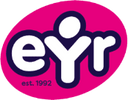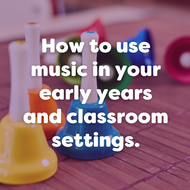How to use music in your early years and classroom settings.
Posted by EYR Team on 20th Nov 2023
read more
It has been proven that music plays a key role in brain development as it contributes to learning language, motor, emotional intelligence and collaboration skills. With early years educators constantly on the lookout for innovative ways to create engaging and nurturing environments, music often stands out as a tool to be harnessed. In this blog, we will delve into the benefits of using music in your classroom and learning setting. We'll also supply you with a variety of suggestions for ways to seamlessly incorporate it into your day-to-day!
The Benefits of Music on Areas of Learning
Cognition
The pattern and melodies of music have been found to engage the brain’s neural pathways which in turn can enhance cognitive abilities in children. More specifically, research has shown that exposure to music can stimulate memory, attention and problem-solving skills.
Emotional wellbeing
As we all know, music has the ability to evoke emotion and provides an avenue for self-expression. Engaging in music-making activities like singing or playing musical instruments can not only raise spirits but can cultivate a positive classroom environment, fostering a sense of improved emotional well-being.
Social skills
By singing together or even participating in musical games, children will learn social interaction, turn-taking and effective communication. On top of this, music offers a universal platform for children from different backgrounds to connect and communicate at a shared level and build relationships.
Multisensory learning
Music appeals to multiple senses simultaneously which can create a rich learning experience. By combining visual and kinaesthetic elements with the auditory stimulation that music provides, you can engage your little ones and help them absorb information more effectively.
Ways to incorporate music into your classroom
1. Set the tone

Music can be a great way to set the tone of an environment – there is a reason they play calming music at a spa over heavy metal!
This could be used to great effect in the classroom also! Why not start off the day with some soft classical music to get the children ready for learning? Studies have shown that classical music in particular can produce a calming effect due to the dopamine release and inhibition of the stress hormones which together stimulate a great mood.
Alternatively, if you find your little ones are lagging a bit during the day or during a particular lesson why not shake things up with a quick boogie? Dancing to music for 30 seconds can be a great mood lifter and re-energise your children to get stuck back into learning with a refreshed mindset.
2. Use it as a hook
As educators, there is often a key piece of information in your lessons that you particularly want the little ones to absorb. Some teachers take this opportunity to wave a flag to indicate extra attention is needed but why not try playing a quick bit of music? The change in the atmosphere will alert the children and they will soon come to learn that this particular piece of music means they need to listen up!
3. Brain breaks

Like the two suggestions above, music can be used to indicate a change in learning such as brain breaks or when you are moving into a different topic. When using music for this effect we suggest using a simple instrument like a singing bowl or a chime to bookend a lesson or a “brain break”.
Again your little ones will become accustomed to the sound and learn what this symbolises during the day.
4. Enhance memory
Think about how we learn the alphabet – we follow a rhythm that is as old as time! Why not apply this theory to other pieces of information you want your little ones to absorb and retain? Adding a rhythm or turning the information into a song will help retention and retrieval when it is needed until this information becomes ingrained. For a bit more fun why not have your little ones make up a song themselves with key pieces of information – this will support memory retention even further and make for a fun lesson activity!
Another way in which music can be used to enhance memory is to play a song or tune on repeat when learning a particular piece of information or skill. Then when this music or tune is played at a later date – the skill and information will be easier to retrieve from memory.

5. Learn with music

Finally, why not incorporate music into your lessons? One way in which to do this is to incorporate it into your STEAM topics, try filling up different cups or bottles with various levels of water and tapping on the top – see if your children can hear the different sounds that each one will make.
For another effective way to incorporate music into learning, why not clap along when reading or listening. This is a simple yet effective way to support children’s communication and language skills as they clap through the words and stories
We would love to hear all about how you use music in the classroom and in your setting! Share your experiences with us on social media by tagging us or using the hashtag #ExploreWithEYR

